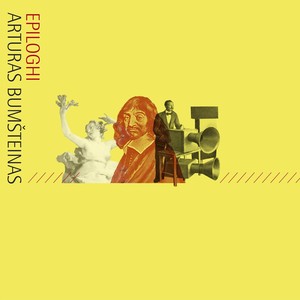
Epiloghi. (Six Ways of Saying Zangtumbtumb)
- 流派:Jazz 爵士
- 语种:英语
- 发行时间:2013-11-15
- 类型:录音室专辑
- 歌曲
- 时长
-
Epilogue 1, Desire
-
Epilogue 2, Hate
-
Epilogue 3, Love
-
Epilogue 4, Sadness
-
Epilogue 5, Joy
-
Epilogue 6, Wonder
简介
“Epiloghi. Six Ways of Saying Zangtumbtumb” for historic theater noise machines and the sounds of stage machinery, harpsichords, fortepiano, female voice and archival recording of F.T.Marinetti's voice This composition is a multiple homage to Luigi Russolo's manifesto “Art of Noises“ (1913), René Descartes' philosophical treatise “Passions of the Soul” (1649) and Jacopo Peri's opera “Dafne” (1598). The motto of this composition is affects versus effects. Each of it's six parts is a hypothetical epilogue to the lost Peri's opera “Dafne” (which is the earliest known work that is today considered an opera). Each of these epilogues is based on one of the basic human affects - desire, hate, love, sadness, joy and wonder (as it is proposed by Descartes). Further on - each emotion is paired with one “family of noises” from Russolo's “Art of Noises” manifesto and each of these “families of noises” found it's own equivalent on Baroque theater's stage. These so-called equivalents of the Futurist Intonarumori noise instruments are the noise-making machines that were used in Baroque theater performances in order to illustrate the phenomena of nature such as wind, thunder, rain, storm etc. The noise-machines can still be found in several historical European theaters and that's where they were recorded together with various other sounds of the stage machinery. The instrumental parts were composed by employing melodic/harmonic materials from around two hundred various popular melodies ranging from 16th to 21st century. Despite the title, only one part of the whole composition is directly related to “Zang Tumb Tumb” (1914) - poem by the Futurist poet Filippo Tommaso Marinetti. Composer: Arturas Bumšteinas Harpsichords, fortepiano and voice: Christine Kessler Historic theater noise-machines and stage machinery: Arturas Bumšteinas, Per Simon Edström, Sofia Borg, Christer Nilsson, John Kapenekas, Kati Schmidt und Eimantas Ludavičius. Voice sample: Filippo Tommaso Marinetti Recording engineer: Andreas Stoffels (Studio P4, Berlin) Harpsichord tuner: Markus Fischinger Assistant to composer: Neele Hülcker Producer: Marcus Gammel, Klangkunst, Deutschlandradio Kultur 2013 Theater noise-machines courtesy of: Drottningholm Palace Theater, Stockholm Music and Theater Museum, Arena Theater Institute, Ekhof-Theater at Schloss Friedenstein Gotha, Eimantas Ludavičius' studio. Special thanks to: Elektronmusikstudion (EMS), Viktoria Tkaczyk, Oliver Sturm, Luciano Chessa. “Epiloghi. Six Ways of Saying Zangtumbtumb” received “Palma Ars Acustica” EURORADIO award for the best Radio Art production of the year 2013. "Night on the Sailship“ for historic theater noise machines and the sounds of stage machinery “Night on the Sailship” is based on the recordings of theater noise machines, stage prop and coulisse machinery. This composition is an imaginary nocturnal soundtrack for the large sailing ship (a barque or a brig). In the old days of theater the technical crew had to be trained as sailors in order to operate the complicated rigging mechanisms of the stage machinery. “Night on the Sailship” is dedicated to Per Simon Edström - a prominent Swedish theater artist and chairman of the Republican Sailors Yacht Club in the Kingdom of Sweden. Composer and recording engineer: Arturas Bumšteinas Historic theater noise machines and stage machinery operated by Arturas Bumšteinas, Per Simon Edström, Sofia Borg, Christer Nilsson, John Kapenekas, Kati Schmidt und Eimantas Ludavičius. Premiered as a multi-channel acousmatic composition at Avant Avantgarde Festival 2013, Cologne.






